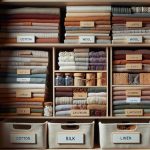When it comes to storing fabrics, you'll want to make sure you're following best practices to maintain their quality and longevity. Start by choosing a cool, dry environment to prevent any moisture damage. Using fabric hangers, garment bags, and acid-free tissue paper can help keep your fabrics free from creases and wrinkles. Additionally, paying attention to light exposure and organizing by fabric type are important steps. But what about the specific techniques for folding or rolling different fabrics, and how do you effectively control temperature and humidity? Let's explore these essential methods further.
Table of Contents
Key Takeaways
- Store fabrics in cool, dry conditions with stable temperature and humidity levels.
- Use acid-free storage materials like archival boxes and tissue paper to prevent deterioration.
- Employ UV-blocking window films and opaque containers to protect fabrics from light damage.
- Regularly inspect and rotate fabrics to identify signs of wear and ensure even usage.
- Use sealed containers and natural pest repellents to prevent pest infestations.
Choosing the Right Storage Environment
Why is it important to choose the right storage environment for your fabrics?
Mastering fabric preservation starts with understanding that your storage environment directly impacts fabric longevity. When you control moisture levels, you're not just preventing mold and mildew; you're actively protecting the fibers from weakening over time. Moisture control is significant because even slight humidity can lead to irreversible damage.
To maintain optimal fabric longevity, you need to store your fabrics in a cool, dry place. The environmental impact of neglecting these conditions can be devastating. Excessive heat can cause fabrics to become brittle, while too much cold can make them susceptible to cracking. By maintaining a stable environment, you're safeguarding not just the fabric itself but also the time, effort, and resources you've invested in acquiring and maintaining it.
Moreover, consider the broader environmental impact. Properly stored fabrics last longer, reducing the need for frequent replacements. This approach not only saves you money but also contributes to a more sustainable lifestyle.
Properly Folding and Rolling Fabrics
When folding and rolling fabrics, you'll want to avoid creases and wrinkles to keep them looking fresh. By doing this, you can also maximize your storage space and keep everything organized by fabric type.
Let's explore how these techniques can make your fabric storage more efficient.
Avoiding Creases and Wrinkles
Wondering how to keep your fabrics free from creases and wrinkles? Properly folding and rolling fabrics is essential, but there are additional steps you can take to guarantee your materials stay pristine. Start by using fabric hangers and garment bags for delicate or high-value fabrics. Hanging items reduces the risk of deep creases, while garment bags provide protection from dust and light exposure.
For fabrics that must be stored flat or rolled, use a fabric steamer or a wrinkle release spray before storing them. This helps to smooth out any existing wrinkles and prepares the fabric for long-term storage. When folding, try to avoid sharp creases by using acid-free tissue paper between layers.
Here are three best practices to maintain your fabrics:
- Utilize Fabric Hangers: Hang items whenever possible to avoid creases.
- Employ Fabric Steamers: Steam fabrics before storing to eliminate wrinkles.
- Use Acid-Free Tissue Paper: Place tissue paper in folds to prevent sharp creases.
Maximizing Storage Space
Maximizing storage capacity starts with properly folding and rolling your fabrics to make the most of the available area. Begin by neatly folding fabrics into uniform sizes. This not only optimizes space but also allows for easier stacking.
For particularly delicate fabrics, consider rolling them instead. Rolling reduces the risk of permanent creases and utilizes vertical space effectively.
Next, employ vacuum sealing to further condense your fabric collection. Vacuum sealing noticeably shrinks the volume, allowing you to store more in a smaller area. Make sure that your fabrics are clean and dry before sealing to prevent any mold or mildew growth.
Using garment bags can also help maintain the integrity of your fabrics while saving space. Hang these bags in your closet, utilizing hanging storage to keep fabrics wrinkle-free and easily accessible.
For smaller pieces, employ space saving bags which can be compressed to fit into tight spaces.
Organizing by Fabric Type
To keep your fabric collection organized and easy to navigate, start by grouping fabrics by type before folding or rolling them. This step ensures that you can quickly locate the material you need while maintaining best fabric care. By categorizing fabrics such as cotton, silk, and wool, you can implement storage solutions tailored to each fabric type's unique needs.
When organizing, consider color coordination within each fabric type. This not only adds visual appeal but also helps in quickly identifying specific fabrics. Proper folding or rolling techniques are essential to prevent creases and preserve the fabric's integrity. For example, roll delicate fabrics like silk to avoid harsh lines, while sturdy materials like denim can be neatly folded.
Here are some tips to enhance your fabric storage:
- Use acid-free tissue paper: Place it between layers to prevent color transfer and damage.
- Employ clear storage bins: These provide visibility and protect fabrics from dust and pests.
- Label each section: Clearly mark categories and colors to streamline your selection process.
Using Acid-Free Storage Materials
When storing fabrics, it's significant to use acid-free materials to prevent deterioration and discoloration over time. Acid-free storage solutions are essential for effective preservation methods and ensuring the long-term care of your fabrics.
Regular boxes, tissue papers, and plastic containers often contain acids and chemicals that can damage delicate textiles. Instead, opt for archival-quality boxes and acid-free tissue paper. These materials provide a safe environment, reducing the risk of yellowing, brittleness, and fiber breakdown.
To start, wrap your fabrics in acid-free tissue paper. This creates a protective barrier against dust and pollutants. For added protection, store the wrapped fabrics in acid-free boxes. These boxes are designed to regulate humidity levels, another vital factor in fabric preservation. Avoid overstuffing these boxes; give your fabrics room to breathe and prevent unnecessary creasing.
Protecting Fabrics From Light
Exposure to light can cause fabrics to fade and weaken, therefore storing them in dark, well-shielded environments is crucial. To achieve the best fabric preservation, you need to employ effective light protection methods. One of the most efficient strategies is using UV blockers to shield your fabrics from harmful ultraviolet rays. These blockers can be applied in various forms, such as window films or specialized storage boxes.
Consider the following light protection methods to safeguard your fabrics:
- Use UV-blocking window films: Apply these films to windows in storage areas to filter out harmful UV rays, ensuring minimal light exposure.
- Choose opaque storage containers: Store your fabrics in boxes or bins that block out all light, especially if they contain UV inhibitors, to keep them well-protected.
- Install blackout curtains or shades: These are particularly effective for rooms with significant natural light, providing an additional layer of defense against light exposure.
Controlling Temperature and Humidity
To keep your fabrics in peak condition, you need to control both temperature and humidity. Aim for a best temperature range and maintain the right humidity levels to prevent mold growth.
Optimal Temperature Range
Maintaining an ideal temperature range is crucial for preserving the quality and longevity of your fabrics. Effective temperature control is a cornerstone of fabric preservation, securing your textiles remain in excellent condition.
Aim to store your fabrics in an environment where the temperature is stable and moderate, avoiding extremes that can cause irreversible damage.
A dependable temperature range for storing most fabrics usually falls between 60°F and 75°F (16°C to 24°C). This range minimizes the risk of degradation and helps sustain the structural integrity of the fibers.
Key considerations include:
- Avoiding Extreme Temperatures: Fluctuations can lead to brittleness and weakening of fibers.
- Regular Monitoring: Routinely check the temperature to ensure it stays within the ideal range.
- Proper Ventilation: Sufficient airflow aids in maintaining a steady temperature and preventing hotspots.
Humidity Level Control
Keeping humidity levels in check is just as essential as managing temperature when it comes to fabric preservation. High humidity can cause fibers to weaken, discolor, and develop unpleasant odors. You'll want to maintain a relative humidity (RH) level between 45% and 55% to ensure ideal fabric conditions.
Using a dehumidifier is an effective way to control humidity levels. Place it in your storage area to remove excess moisture from the air. Modern dehumidifiers come with built-in hygrometers, allowing you to monitor and adjust RH levels easily. Make sure to empty the water reservoir regularly and clean the filters to maintain efficiency.
Moisture prevention is key to extending the life of your fabrics. Avoid storing fabrics in basements or attics where humidity levels can fluctuate dramatically. Instead, choose a climate-controlled environment.
If a dehumidifier isn't an option, consider using moisture-absorbing packets or silica gel packs to protect your fabrics. These small, cost-effective solutions can make a significant difference in maintaining the integrity of your textiles.
Preventing Mold Growth
Proper temperature and humidity control is vital for preventing mold growth on stored fabrics. To achieve this, you'll need to focus on moisture prevention and effective ventilation techniques. Ideally, you should maintain a storage environment with a humidity level below 60% and a stable temperature between 60-75°F. These conditions will greatly reduce the chances of mold spores thriving on your fabrics.
In addition to regulating the climate, it's essential to implement practices such as fabric rotation and usage monitoring. Routinely rotating your fabrics ensures that no single piece remains in storage for too long, which can help prevent mold accumulation. Monitoring usage also allows you to identify any early signs of mold growth and address them promptly.
Consider the following best practices:
- Use dehumidifiers and hygrometers: These tools help you maintain the best humidity levels and monitor changes in real time.
- Promote proper ventilation: Encourage air circulation by using fans or opening vents, which helps keep moisture levels in check.
- Inspect and rotate fabrics regularly: By rotating and inspecting your fabrics, you can catch potential issues early and guarantee even exposure to air.
Keeping Fabrics Pest-Free
To guarantee your fabrics stay pest-free, regularly inspect and clean storage areas to deter insects and rodents. Pest prevention starts with a clean environment, so vacuum and dust your storage space frequently. Use sealed containers to store fabrics, ensuring pests can't access them.
Natural remedies offer an effective and eco-friendly approach to fabric protection. Essential oils, such as lavender, cedarwood, and eucalyptus, can repel pests. Place a few drops of these oils on cotton balls and distribute them throughout your storage area. Not only will this keep your fabrics safe, but it will also leave a pleasant aroma.
Another method involves using sachets filled with dried herbs like rosemary, thyme, or mint. These herbs act as natural deterrents to pests and are a chemical-free alternative to traditional repellents.
Additionally, cedar blocks or chips can be placed in storage containers or around your storage area. Cedar naturally repels moths and other insects, providing long-lasting protection for your fabrics.
Regularly Inspecting and Maintaining Storage
Maintaining a pest-free environment is just the beginning; you should also regularly inspect and upkeep your fabric storage to guarantee long-term protection. Regular maintenance guarantees your fabrics remain in pristine condition, free from dust, mold, or unseen damage. Make it a habit to periodically check your storage area and the fabrics themselves.
Conducting thorough inspections allows you to monitor the fabric condition effectively. Look for signs of wear, discoloration, or any form of deterioration. This proactive approach helps you address issues before they escalate.
Incorporate fabric rotation into your routine. Rotating your fabrics prevents prolonged pressure on specific areas, reducing the risk of permanent creases or damage. This is particularly useful for delicate or high-value textiles.
Here are a few advanced tips for maintaining your fabric storage:
- Climate Control: Guarantee your storage area maintains a consistent temperature and humidity level. Fluctuations can damage fabrics over time.
- Proper Ventilation: Allow airflow to prevent mold and mildew growth. Stagnant air can be detrimental to fabric longevity.
- Cleanliness: Keep the storage area clean and dust-free. Regularly vacuum and wipe down surfaces to avoid dust accumulation.
Frequently Asked Questions
How Can I Store Fabrics in Small Living Spaces?
You can store fabrics in small living spaces by using creative storage solutions like under-bed bins or hanging organizers. Prioritize fabric organization with clear bins and labels. These fabric storage ideas will help in maximizing small spaces.
What Are the Best Ways to Label Stored Fabrics?
Coincidentally, the best labeling techniques for fabric organization also maximize storage solutions. Use clear, consistent labels on bins and shelves. It's space-saving to categorize by type and color, ensuring you quickly find what you need.
How Do I Store Large Quantities of Fabric Effectively?
You should use fabric organization systems like clear bins or hanging organizers for efficient fabric storage. Implement closet solutions with shelves and racks to maximize space saving, ensuring your large quantities of fabric remain accessible and tidy.
Can I Store Fabrics in Vacuum-Sealed Bags?
Imagine your fabric stash like a treasure chest. Storing fabrics in vacuum-sealed bags maximizes space and protects from dust and moisture. This method enhances fabric organization and offers vacuum-sealed benefits, ensuring your treasures stay pristine.
How Do I Prevent Fabric Colors From Fading During Storage?
To prevent fabric colors from fading during storage, avoid direct sunlight, and use breathable containers to maintain airflow. This approach also helps in preventing mold growth, ensuring your fabrics stay vibrant and in excellent condition.
- Why Open-Weave Scrim Is the Secret to Stunning Event and Canopy Designs - June 26, 2025
- Creating Large-Scale Art Installations With Scrim Fabric - June 26, 2025
- Scrim Fabric in Upholstery: Understanding Its Use as a Backing Material - June 26, 2025







